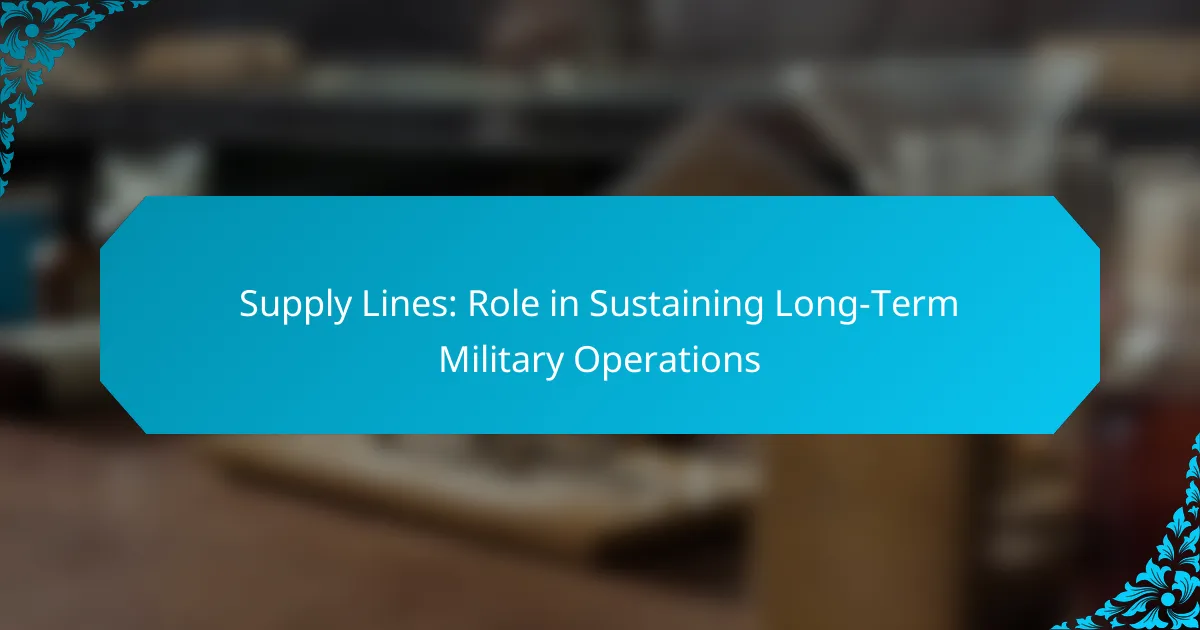The success of the Normandy Invasion, known as D-Day, hinged on the effective management of logistics, which ensured the timely delivery of essential supplies and coordinated efforts among Allied forces. Overcoming significant challenges such as limited resources and enemy resistance required meticulous planning and innovative technology, which played a pivotal role in the operation’s execution.

How Did Logistics Influence the Normandy Invasion?
Logistics played a critical role in the success of the Normandy Invasion by ensuring the timely delivery of supplies, effective transportation, and coordinated efforts among Allied forces. The meticulous planning and execution of logistical operations were essential to overcoming the challenges of the operation.
Supply chain management
Effective supply chain management was vital for the Normandy Invasion, involving the procurement, storage, and distribution of essential materials. This included food, ammunition, medical supplies, and equipment necessary for the troops. The Allies established supply depots in the UK and utilized a network of trucks and ships to ensure that resources were available when and where they were needed.
To manage the vast quantities of supplies, the Allies implemented a just-in-time approach, minimizing waste while ensuring that troops were well-equipped. This required precise forecasting and constant communication between supply units and frontline commanders.
Transportation strategies
Transportation strategies were crucial for moving troops and equipment across the English Channel and onto the beaches of Normandy. The Allies used a combination of naval vessels, landing craft, and trucks to facilitate this movement. The use of specialized landing ships, such as LSTs (Landing Ship Tanks), allowed for the direct offloading of vehicles and supplies onto the beach.
Additionally, the establishment of temporary ports, known as Mulberries, enabled the rapid unloading of supplies once the beachhead was secured. This innovative approach significantly increased the volume of supplies that could be delivered during the critical early days of the invasion.
Coordination of Allied forces
Coordination among the diverse Allied forces was essential for the success of the Normandy Invasion. The operation involved troops from the United States, the United Kingdom, Canada, and other nations, each with its own command structure and logistical needs. Effective communication and planning were necessary to synchronize movements and ensure that all forces operated in concert.
Joint planning sessions and the establishment of unified command helped streamline operations. Regular updates on supply status and troop movements allowed for quick adjustments, which were crucial in responding to the dynamic battlefield conditions.
Impact of weather on logistics
Weather significantly impacted logistics during the Normandy Invasion, with the timing of the operation heavily influenced by tidal and meteorological conditions. The Allies needed favorable weather for the amphibious landings, which required careful planning and monitoring of forecasts.
On June 6, 1944, the invasion was launched during a brief window of improved weather conditions, despite earlier forecasts predicting poor visibility and rough seas. This decision underscored the importance of flexibility in logistics, as the operation could have been delayed for weeks due to unfavorable weather.
Use of deception tactics
Deception tactics played a crucial role in the logistics of the Normandy Invasion by misleading German forces about the true landing site. Operation Fortitude involved creating a fictitious army group in southeast England, complete with fake equipment and radio traffic, to divert German attention away from Normandy.
This successful deception allowed the Allies to concentrate their logistical efforts on the actual landing sites without facing overwhelming German defenses. The element of surprise was a key factor in the initial success of the invasion, demonstrating how logistics and strategy can work hand in hand.

What Were the Key Logistics Challenges Faced?
The Normandy Invasion, or D-Day, encountered several critical logistics challenges that significantly impacted its success. These challenges included limited resources, enemy resistance, difficult terrain, and communication barriers, each of which required careful planning and execution to overcome.
Limited resources
One of the primary logistics challenges was the limited resources available for the invasion. The Allied forces had to manage a vast array of supplies, including ammunition, food, and medical equipment, while ensuring they had enough landing craft and vehicles to transport troops. Efficient allocation and prioritization of these resources were crucial to maintaining momentum during the operation.
To address resource limitations, planners developed a detailed supply chain strategy, utilizing ports in England and stockpiling essential materials. This approach ensured that troops had access to necessary supplies as they advanced inland, minimizing the risk of shortages.
Enemy resistance
Enemy resistance posed a significant logistics challenge during the Normandy Invasion. The German forces had fortified positions along the coastline, creating obstacles for landing troops and equipment. This resistance not only slowed the advance but also complicated supply routes, as units faced direct attacks while trying to establish a foothold.
To counteract this challenge, the Allies conducted extensive aerial bombardments to weaken German defenses before the landings. Additionally, they coordinated simultaneous assaults across multiple beaches to disperse enemy forces and create opportunities for successful landings.
Terrain difficulties
The terrain along the Normandy coast presented numerous difficulties for the invading forces. The beaches were heavily fortified and featured obstacles such as barbed wire and mines, which hindered troop movements and supply deliveries. The inland areas were also characterized by hedgerows and steep hills, complicating transportation and logistics.
To navigate these challenges, the Allies employed specialized equipment, such as amphibious vehicles and bulldozers, to clear obstacles and create safe pathways. Understanding the terrain’s impact on logistics allowed commanders to adjust their strategies and maintain supply lines effectively.
Communication barriers
Communication barriers significantly affected the logistics of the Normandy Invasion. Coordinating between various Allied forces, including American, British, and Canadian troops, required effective communication systems. However, the chaos of battle and the destruction of communication lines often led to confusion and delays in relaying critical information.
To mitigate these issues, the Allies implemented robust communication protocols, utilizing radio and signal flags to maintain contact. Regular updates and briefings helped ensure that all units were aware of their objectives and logistics plans, facilitating smoother operations despite the inherent challenges of wartime communication.

What Role Did Technology Play in Logistics?
Technology was crucial in the logistics of the Normandy Invasion, enabling efficient transportation, real-time reconnaissance, and advanced supply chain management. These innovations significantly enhanced the Allied forces’ ability to coordinate and execute the operation effectively.
Advancements in transportation
The Normandy Invasion relied heavily on advancements in transportation technology, particularly the use of landing craft and amphibious vehicles. These innovations allowed troops and equipment to be delivered directly onto the beaches, overcoming the challenges posed by the heavily fortified coastline.
Additionally, the development of specialized transport ships, such as the LST (Landing Ship Tank), facilitated the rapid movement of large quantities of supplies and vehicles. This capability was essential for sustaining the invasion forces during the critical early days of the operation.
Use of aerial reconnaissance
Aerial reconnaissance played a vital role in logistics by providing real-time intelligence on enemy positions and terrain. High-altitude bombers and reconnaissance aircraft gathered crucial data that informed planning and execution, allowing Allied commanders to make informed decisions about troop deployments and supply routes.
The use of aerial photography and mapping technologies enabled the Allies to assess the beach defenses and identify potential landing zones, which was instrumental in the success of the operation. This intelligence helped minimize risks and optimize logistics on the ground.
Innovations in supply chain technology
Supply chain technology innovations, such as the implementation of standardized shipping containers and efficient inventory management systems, were pivotal during the Normandy Invasion. These advancements streamlined the process of moving goods from ports to the front lines, ensuring that troops received necessary supplies promptly.
Moreover, the establishment of a robust communication network allowed for better coordination between supply depots and frontline units. This integration of logistics and communication technology ensured that resources were allocated effectively, reducing waste and delays during the operation.

How Were Logistics Coordinated Among Allies?
Logistics coordination among the Allies during the Normandy Invasion was crucial for ensuring the success of the operation. This involved meticulous planning, effective integration of military branches, and the establishment of clear command structures to manage resources and personnel efficiently.
Joint planning meetings
Joint planning meetings were essential for aligning the strategies of the Allied forces. These meetings brought together military leaders from the United States, the United Kingdom, and other nations to discuss objectives, share intelligence, and coordinate logistics. Regular sessions helped to refine plans and address potential challenges before the invasion.
During these meetings, leaders would assess the logistical needs, such as troop movements, supply routes, and equipment requirements. This collaborative approach ensured that all parties were on the same page, reducing the risk of miscommunication and operational delays.
Integration of military branches
The integration of military branches, including the Army, Navy, and Air Force, was vital for the success of the Normandy operation. Each branch had specific roles, and their collaboration was necessary to execute a complex amphibious assault. For instance, naval forces provided bombardment support while air forces conducted reconnaissance and air cover.
Effective integration meant that logistics had to be synchronized across these branches. This involved coordinating transport ships, landing craft, and aircraft to ensure that troops and supplies arrived at the right time and place. Clear communication channels were established to facilitate this integration and minimize logistical bottlenecks.
Establishment of command structures
Establishing command structures was critical for managing the vast resources involved in the Normandy Invasion. A unified command allowed for streamlined decision-making and efficient allocation of logistics. General Dwight D. Eisenhower served as the Supreme Commander, overseeing operations and coordinating efforts among the Allies.
Command structures included various levels of leadership that addressed both strategic and tactical logistics. This hierarchical approach ensured that logistical decisions could be made quickly and effectively, adapting to the evolving situation on the ground. The clear chain of command helped maintain order and focus during the chaotic initial stages of the invasion.

What Lessons Can Be Learned from the Normandy Invasion?
The Normandy Invasion, also known as D-Day, offers critical insights into logistics planning and execution in military operations. Key lessons include the importance of thorough preparation, effective communication, and the need for adaptability in the face of unforeseen challenges.
Importance of Logistics Planning
Logistics planning was a cornerstone of the Normandy Invasion’s success. It involved meticulous coordination of resources, personnel, and transportation to ensure that troops and supplies reached the battlefield on time. Effective logistics planning can significantly influence the outcome of any large-scale operation.
For military operations, this means establishing clear supply lines, anticipating potential disruptions, and ensuring that all units are equipped with the necessary resources. A well-structured logistics plan can reduce delays and enhance operational efficiency.
Coordination and Communication
Successful execution of the Normandy Invasion relied heavily on coordination and communication among various Allied forces. Clear communication channels ensured that all units were informed of their roles and the overall strategy. This level of coordination is essential in any complex operation.
In practice, this involves regular updates, joint training exercises, and the use of reliable communication technology. Establishing a unified command structure can streamline decision-making and enhance responsiveness to changing conditions on the ground.
Adaptability in Operations
The Normandy Invasion demonstrated the necessity of adaptability when facing unexpected challenges. Weather conditions, enemy resistance, and logistical hurdles required commanders to make real-time adjustments to their plans. Flexibility is crucial in any operational context.
To foster adaptability, organizations should encourage a culture of innovation and empower leaders to make decisions based on the evolving situation. Conducting regular scenario planning can also help teams prepare for potential contingencies and respond effectively when plans need to change.



